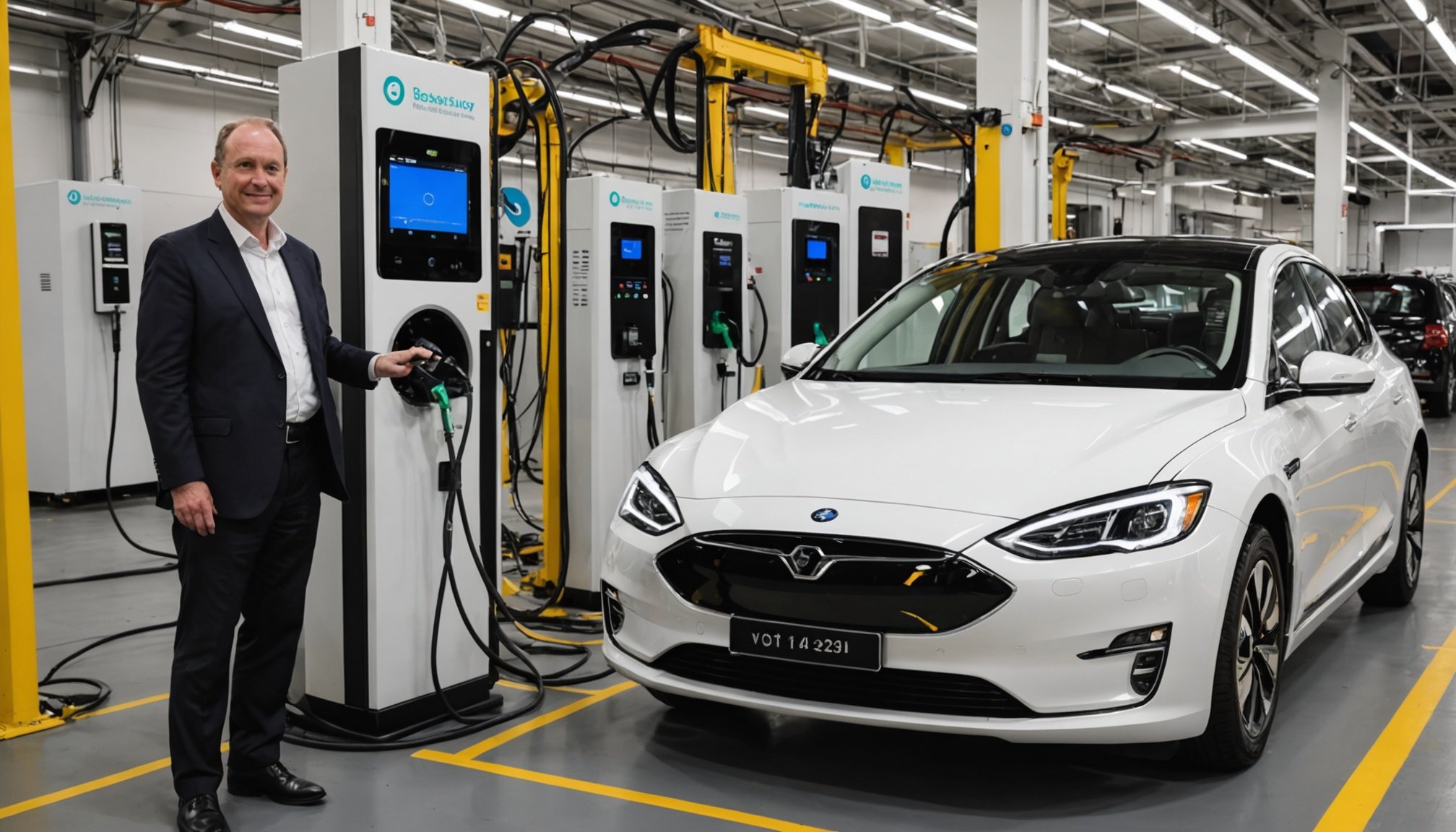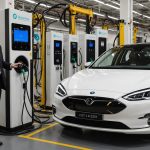Revolutionary Innovations Transforming Electric Vehicle Batteries for Extended Range and Rapid Charging
The electric vehicle (EV) industry is on the cusp of a significant transformation, driven by groundbreaking innovations in battery technology. These advancements are not only extending the range of EVs but also enabling faster charging, making electric mobility more practical and appealing to a wider audience. Here’s a deep dive into the latest developments that are reshaping the future of electric vehicles.
The Evolution of Lithium-Ion Batteries
Lithium-ion batteries have been the cornerstone of the EV industry, and their evolution is a testament to the relentless pursuit of better performance and efficiency.
Also to see : How AI Revolutionizes Traffic Management to Alleviate Congestion in Urban Centers During Rush Hours
New Materials and Designs
Companies like Tesla are pushing the boundaries with new battery technologies. For instance, Tesla is on the verge of introducing its 4680D batteries, which employ a “dry” manufacturing technique and incorporate silicon-carbon materials. These batteries promise significant improvements in energy density and power density, translating to longer driving ranges and faster charging times[2].
| Feature | Current 4680 Cells | 4680D Cells |
|
|--------------------|
|
| Manufacturing Technique| Wet | Dry |
| Materials | Nickel, Manganese, Cobalt | Silicon-Carbon |
| Energy Density | High | Significantly Higher |
| Power Density | High | Improved |
| Charging Speed | Fast | Faster |
| Production Challenges | Established | New, with initial slowdowns |
High-Silicon Anodes
Another significant development is the use of high-silicon anodes in conventional lithium-ion batteries. Companies like Group14 are pioneering this technology, which enhances energy density and power density. High-silicon anodes can improve charging speeds dramatically, with some cells charging in under ten minutes[4].
In parallel : Harnessing AI for Proactive Maintenance in Urban Public Transport Systems: Uncovering the Future of Predictive Analytics
Solid-State Batteries: The Next Frontier
Solid-state batteries (SSBs) are being hailed as the future of battery technology due to their potential to overcome the limitations of traditional lithium-ion batteries.
Overcoming Dendrite Formation
One of the major challenges with lithium metal anodes in liquid electrolyte cells is the formation of dendrites, which can cause short circuits and fires. Solid-state batteries use solid electrolytes to prevent this issue, making them safer and more reliable[4].
Industry Leaders
Companies like Factorial, QuantumScape, and Solid Power are at the forefront of SSB development. Factorial’s batteries, for example, have achieved over 600 cycles, a significant milestone in the journey towards commercial viability[4].
Advanced Battery Assembly and Design
The way batteries are assembled and designed is also undergoing a significant transformation, driven by the need for better performance, cost efficiency, and sustainability.
Cell-Module-Pack (CMP), Cell-to-Pack (CTP), and Cell-to-Body (CTB) Designs
Traditional CMP designs are being replaced by more efficient CTP and CTB designs. CTP designs integrate cells directly into the battery pack, reducing parts and weight, while CTB designs incorporate cells into the vehicle’s body, optimizing space and structural integrity[5].
| Design Type | Characteristics | Advantages | Challenges |
|
|--------------------------------------------------------------------------------|
|-----------------------------------------------------------------------------|
| Cell-Module-Pack (CMP)| Individual cells packaged into modules | Durability, ease of assembly, serviceability | Higher cost, weight, and bulk |
| Cell-to-Pack (CTP) | Cells integrated directly into the battery pack | Enhanced energy density, simplified manufacturing, cost reduction | Complex assembly process, thermal management issues |
| Cell-to-Body (CTB) | Cells incorporated into the vehicle’s body | Optimized space, reduced weight, improved structural integrity | Concerns about durability, recyclability, and safety |
The Role of Adhesives in EV Battery Design
Adhesives are emerging as a critical component in EV battery assembly, offering enhanced performance, safety, and sustainability.
Enhanced Performance and Safety
Advanced adhesive technologies optimize the thermal interface between battery cells and cooling systems, leading to extended range and faster charging. They also contribute to crash energy management and provide continuous bond lines that enhance the structural integrity of the battery pack[5].
Sustainability
Adhesives play a crucial role in sustainable battery design by enabling the use of various materials, preserving substrate integrity, and supporting innovative designs that were previously unattainable. For instance, DuPont’s adhesive solutions are designed to address pressing challenges while enhancing EV performance and safety[5].
Battery Recycling and End-of-Life Management
As the number of EVs on the road increases, the issue of battery recycling and end-of-life management becomes more pressing.
Policy Initiatives
States like New Jersey and California are implementing policies to ensure safe handling and end-of-life management of EV batteries. New Jersey’s Electric and Hybrid Vehicle Battery Management Act, for example, requires EV battery producers to create and submit battery management plans to the state’s Department of Environmental Protection[1].
Environmental and Economic Benefits
Recycling old EV batteries and using the reclaimed minerals to build new ones reduces environmental impacts, such as emissions, forced labor, and land and water use associated with mining critical minerals. It also helps meet supply gaps and promotes financial sustainability[1][3].
Charging Infrastructure and Supply Chain Innovations
The development of efficient charging infrastructure and the optimization of the supply chain are crucial for the widespread adoption of EVs.
Charging Infrastructure
The Inflation Reduction Act provides incentives for the development of domestic charging infrastructure, making EVs more accessible and affordable. Fast-charging technologies, enabled by advancements in battery technology, are also becoming more prevalent[2][3].
Supply Chain Overhaul
The shift to EV production is transforming the automotive supply chain from the factory floor to the customer door. Proximity between battery manufacturing and EV assembly lines has become crucial due to the weight and safety concerns of batteries. Factories are being retrofitted with specialized equipment, climate-controlled storage, and fire suppression systems to handle these heavy and potentially hazardous components[3].
Practical Insights and Actionable Advice
For those considering the transition to electric vehicles or involved in the EV industry, here are some practical insights and actionable advice:
- Invest in Battery Recycling: Encourage and support battery recycling initiatives to reduce environmental impacts and promote sustainability.
- Stay Informed About New Technologies: Keep an eye on advancements like solid-state batteries and high-silicon anodes, which could significantly improve the performance of your EV.
- Consider Charging Infrastructure: When purchasing an EV, ensure you have access to reliable and fast-charging infrastructure to maximize the benefits of your vehicle.
- Support Policy Initiatives: Advocate for policies that promote safe battery handling and end-of-life management to ensure a sustainable future for EVs.
The future of electric vehicles is bright, thanks to the revolutionary innovations in battery technology. From the introduction of new materials and designs to the development of solid-state batteries and advanced adhesive technologies, the industry is poised for significant growth. As we move forward, it is crucial to address the challenges of battery recycling, end-of-life management, and supply chain optimization to ensure a sustainable and efficient transition to electric mobility.
In the words of Elon Musk, “Enhancing Tesla’s internal battery manufacturing capabilities is vital to the company’s strategy, especially in offering more cost-effective electric vehicles.” This sentiment resonates across the industry, where continuous innovation and improvement are key to driving the future of electric vehicles[2].
As we embark on this journey, it is clear that the next decade will be transformative for the automotive industry, with electric vehicles at the forefront of this revolution. Whether you are a consumer, a manufacturer, or simply an enthusiast, understanding and embracing these innovations will be crucial in shaping the future of electric mobility.











